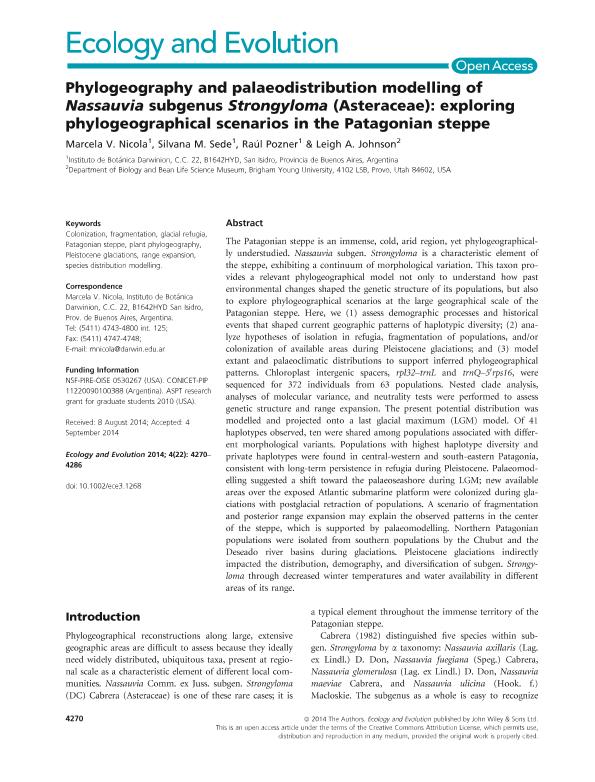Mostrar el registro sencillo del ítem
dc.contributor.author
Nicola, Marcela Viviana

dc.contributor.author
Nicola, Marcela Viviana

dc.contributor.author
Pozner, Raul Ernesto

dc.contributor.author
Johnson, Leigh

dc.date.available
2017-07-05T19:00:31Z
dc.date.issued
2014-11
dc.identifier.citation
Nicola, Marcela Viviana; Nicola, Marcela Viviana; Pozner, Raul Ernesto; Johnson, Leigh; Phylogeography and palaeodistribution modelling of Nassauvia subgenus Strongyloma (Asteraceae): exploring phylogeographical scenarios in the Patagonian steppe; Wiley; Ecology and Evolution; 4; 22; 11-2014; 4270-4286
dc.identifier.uri
http://hdl.handle.net/11336/19637
dc.description.abstract
The Patagonian steppe is an immense, cold, arid region, yet phylogeographically understudied. Nassauvia subgen. Strongyloma is a characteristic element of the steppe, exhibiting a continuum of morphological variation. This taxon provides a relevant phylogeographical model not only to understand how past environmental changes shaped the genetic structure of its populations, but also to explore phylogeographical scenarios at the large geographical scale of the Patagonian steppe. Here, we (1) assess demographic processes and historical events that shaped current geographic patterns of haplotypic diversity; (2) analyze hypotheses of isolation in refugia, fragmentation of populations, and/or colonization of available areas during Pleistocene glaciations; and (3) model extant and palaeoclimatic distributions to support inferred phylogeographical patterns. Chloroplast intergenic spacers, rpl32–trnL and trnQ–5′rps16, were sequenced for 372 individuals from 63 populations. Nested clade analysis, analyses of molecular variance, and neutrality tests were performed to assess genetic structure and range expansion. The present potential distribution was modelled and projected onto a last glacial maximum (LGM) model. Of 41 haplotypes observed, ten were shared among populations associated with different morphological variants. Populations with highest haplotype diversity and private haplotypes were found in central-western and south-eastern Patagonia, consistent with long-term persistence in refugia during Pleistocene. Palaeomodelling suggested a shift toward the palaeoseashore during LGM; new available areas over the exposed Atlantic submarine platform were colonized during glaciations with postglacial retraction of populations. A scenario of fragmentation and posterior range expansion may explain the observed patterns in the center of the steppe, which is supported by palaeomodelling. Northern Patagonian populations were isolated from southern populations by the Chubut and the Deseado river basins during glaciations. Pleistocene glaciations indirectly impacted the distribution, demography, and diversification of subgen. Strongyloma through decreased winter temperatures and water availability in different areas of its range.
dc.format
application/pdf
dc.language.iso
eng
dc.publisher
Wiley

dc.rights
info:eu-repo/semantics/openAccess
dc.rights.uri
https://creativecommons.org/licenses/by/2.5/ar/
dc.subject
Colonization
dc.subject
Fragmentation
dc.subject
Glacial Refugia
dc.subject
Patagonian Steppe
dc.subject
Plant Phylogeography
dc.subject
Pleistocene Glaciations
dc.subject
Range Expansion
dc.subject
Species Distribution Modelling
dc.subject.classification
Ciencias de las Plantas, Botánica

dc.subject.classification
Ciencias Biológicas

dc.subject.classification
CIENCIAS NATURALES Y EXACTAS

dc.title
Phylogeography and palaeodistribution modelling of Nassauvia subgenus Strongyloma (Asteraceae): exploring phylogeographical scenarios in the Patagonian steppe
dc.type
info:eu-repo/semantics/article
dc.type
info:ar-repo/semantics/artículo
dc.type
info:eu-repo/semantics/publishedVersion
dc.date.updated
2017-07-05T18:15:09Z
dc.identifier.eissn
2045-7758
dc.journal.volume
4
dc.journal.number
22
dc.journal.pagination
4270-4286
dc.journal.pais
Estados Unidos

dc.journal.ciudad
Hoboken
dc.description.fil
Fil: Nicola, Marcela Viviana. Consejo Nacional de Investigaciones Científicas y Técnicas. Instituto de Botánica Darwinion. Academia Nacional de Ciencias Exactas, Físicas y Naturales. Instituto de Botánica Darwinion; Argentina
dc.description.fil
Fil: Nicola, Marcela Viviana. Consejo Nacional de Investigaciones Científicas y Técnicas. Instituto de Botánica Darwinion. Academia Nacional de Ciencias Exactas, Físicas y Naturales. Instituto de Botánica Darwinion; Argentina
dc.description.fil
Fil: Pozner, Raul Ernesto. Consejo Nacional de Investigaciones Científicas y Técnicas. Instituto de Botánica Darwinion. Academia Nacional de Ciencias Exactas, Físicas y Naturales. Instituto de Botánica Darwinion; Argentina
dc.description.fil
Fil: Johnson, Leigh. University Brigham Young; Estados Unidos
dc.journal.title
Ecology and Evolution
dc.relation.alternativeid
info:eu-repo/semantics/altIdentifier/url/http://onlinelibrary.wiley.com/doi/10.1002/ece3.1268/abstract
dc.relation.alternativeid
info:eu-repo/semantics/altIdentifier/doi/http://dx.doi.org/10.1002/ece3.1268
Archivos asociados
